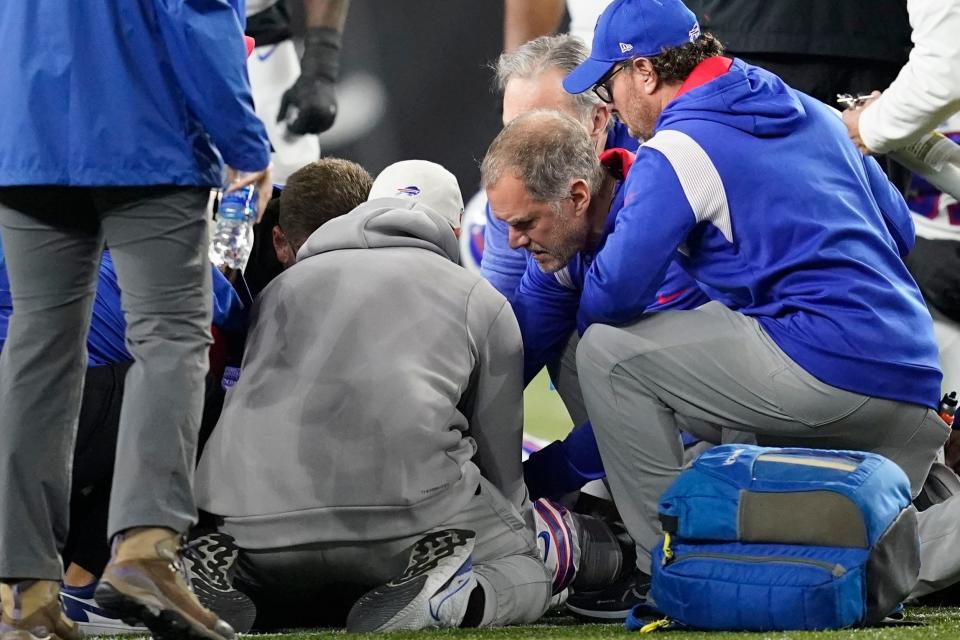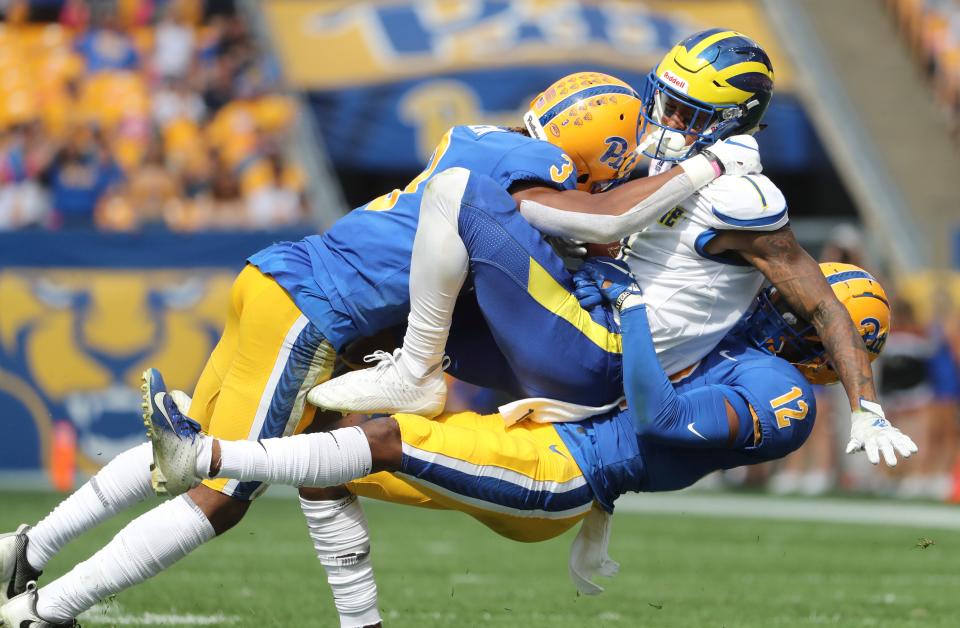Buffalo Bills safety Damar Hamlin's collapse was shocking. What can we learn from it?
Sports fans in Delaware, like those everywhere, felt a grave sense of unease after watching Buffalo Bills safety Damar Hamlin collapse to the turf Monday night in Cincinnati, then learning he’d suffered cardiac arrest.
Medical personnel employed cardiopulmonary resuscitation and an automated external defibrillator, according to reports, before 24-year-old Hamlin was taken by ambulance to the nearby University of Cincinnati Medical Center.
The incident provided an alarming display of the narrow line between life and death and how quickly a healthy individual, while involved in a rigorous activity involving physical contact, can suddenly be in jeopardy.

“As somebody who sees a lot of athletes and tries to assess risk, this is kind of our worst fear come to reality,” said Dr. Neel Chokshi, director of sports cardiology at Penn Medicine. “It’s a very difficult situation to put together. Obviously, we don’t know all the details.”
The Bills announced Thursday that Hamlin has shown “remarkable improvement” and appears to be “neurologically intact” and “making steady progress” while still critically ill.
More:Damar Hamlin update: Buffalo Bills player has breathing tube removed, FaceTimed with teammates
The fact that Hamlin’s life was apparently saved on the field by trained health care experts demonstrated another aspect from which the general public can take a valuable lesson, said Dr. Susan Coffey, director of ChristianaCare’s Virtual Education and Simulation Training Center.
Learn to give CPR.
“It is such a valuable skill set to have,” Coffey said, “and pretty much anyone can learn it and apply it if needed. Families and people in the community should learn how to do CPR.
“It’s called basic life support,” she added, “and it is pretty basic. You are pumping on the chest, and you’re doing the work the heart would be doing. It’s not a hard skill. It can be taught to parents who are having kids, babysitters, lifeguards, Girl Scouts. It’s not anything that’s complicated.”

Coffey called what happened to Hamlin in such a public setting “pretty upsetting” and felt it exemplified the benefits of rapid response with the aid of CPR and an AED.
Those interested in learning how to provide CPR can visit www.cprdelaware.com to find out who is proving instruction and where. The American Red Cross (www.redcross.org) and American Heart Association (cpr.heart.org/en/training-programs) also provide in-person and online training for CPR and AED use.
Coffey added that ChristianaCare trains about 2,800 of its health care workers annually in CPR on mannequins that provide immediate feedback.
2022 IN REVIEW:Top Delaware sports stories of year include one that made national headlines
“When you’re in cardiac arrest, it depends on a lot of different things,” Coffey said. “But doing nothing, you’re not gonna help that person at all. You could potentially save a life by performing CPR or by using an AED.”
What should you know?
CPR training and knowing the location of an AED were among the positive responses outlined by Chokshi that vigilant families could make in the wake of what he termed a “catastrophic” occurrence.
“Being prepared is probably the most important thing,” Chokshi said.
He pointed out how “really hard it is to predict these things,” especially for professional athletes who regularly test their body’s cardiovascular limits but, in doing so, make them stronger.
“Like everyone else I was shocked,” he said. “When it first happened, it looked pretty typical for, unfortunately, a cardiac arrhythmia or heart-related issue just the way he went down. He was seemingly normal, then he had total loss of posture and tone. That’s very classic for a heart-related issue.”
Underlying conditions, previous vascular injuries or family history may contribute to cardiac disturbance, Chokshi added. That’s where families can sometimes play a key preventive role, despite the rarity of such events.
Chronic or congenital problems may be difficult to discover. But if symptoms, such as chest pain or shortness of breath, persist, they should be examined. Previous cardiac events within the family, such as members of previous generations having died suddenly, especially at a young age, should be taken into account, he said.
“Is there a history of hypertrophic cardiomyopathy or aortic aneurysms or enlarged aortas?” Chokshi said of particular areas of concern.
The foundation for all of that, Chokshi added, is continually having routine medical examinations and an honest dialogue with the doctor. Sometimes simply listening to a heartbeat through a stethoscope can be the first step in discovering an abnormality.
“It’s so uncommon but it may be identifying something that may then prompt a test of the heart,” he said.
What led to Hamlin's collapse?
It appeared Bengals receiver Tee Higgins’ shoulder struck Hamlin’s chest as Hamlin tackled him after a reception.
While the Bills have classified Hamlin’s injury only as cardiac arrest, many have wondered if he may have suffered commotio cordis, in which blunt force to the chest disrupts the electrical cycle that sparks the heartbeat.
Delaware cardiologist Dr. Francis Palermo said that if forceful contact with the chest occurs at a precise moment during someone’s heartbeat – specifically during what EKG tests show as the upstroke in the T-wave – it can disrupt the rhythm enough to cause cardiac arrest and death. Palermo said physicians even have to time exactly when to use an automated external defibrillator because it can also cause ventricular fibrillation, an irregular heartbeat that can be fatal if administered at the wrong moment.
“Think of all the times someone gets hit in the chest and nothing happens. Billions of times,” said Palermo, a wrestler and baseball player at Saint Mark’s High in the early 1970s.
“But this was the one time where everything came together. … My guess is he went into ventricular fibrillation because I understand there was CPR and shocking right there on the field.’’
What is commotio cordis?
Commotio cordis can be caused by “any direct blow to the chest,” said Dr. Chaney Stewman, who specializes in sports medicine at ChristianaCare and is the program director of the Sports Medicine Fellowship program.

In sports, it is most common when someone is struck by a projectile, such as a baseball, softball, lacrosse ball or hockey puck, or for those kicking or punching each other in martial arts. Forceful impact from a football helmet can also be a cause, she said.
Like other doctors, Stewman didn’t want to speculate on what exactly caused Hamlin’s cardiac arrest. She described commotio cordis as “a very, very rare and lethal” disruption of the heart’s rhythm that, echoing Palermo, occurs in a tiny time frame measured only in milliseconds.
Lacrosse has added chest padding and pitchers may don protective devices called “heart guards” to decrease the danger. While football shoulder pads do cover part of the chest, Palermo suggested better protection may be valuable, perhaps using Kevlar.
Should athletes be concerned?
Stewman, a former three-sport athlete herself, she said, emphasized that it’s important people know what happened to Hamlin was extremely rare and it shouldn’t discourage their own athletic and fitness pursuits.
“It’s normal for everyone to be so fearful and scared when something like this happens,” Stewman said. “If we just take a pause and realize these are freak accidents, which are very, very rare. They’re more rare than structural heart disease, which is a bigger source for cardiac arrest for athletes on the field and on the sidelines.”
She added that people certainly should have discussions about the risks and benefits of various sports, but stressed that physical fitness remains the best path to productive health.
“Exercise,” she said, “is the best medicine. It’s better than any pill you could ever take.”
Have an idea for a compelling local sports story or is there an issue that needs public scrutiny? Contact Kevin Tresolini at ktresolini@delawareonline.com and follow on Twitter @kevintresolini. Support local journalism by subscribing to delawareonline.com.
This article originally appeared on Delaware News Journal: Damar Hamlin's collapse was stunning. What can we learn from it?

